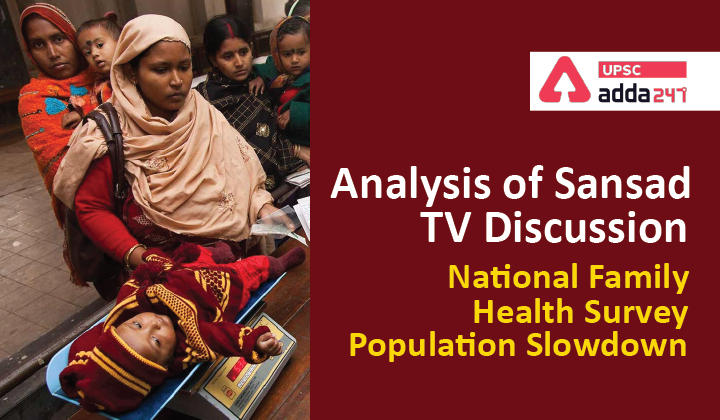Table of Contents
Context
According to the National Family Health Survey data for 2019-21, the country’s population is set to fall as its Total Fertility Rate – which is the average number of children born to a woman over her lifetime has dropped to 2 for the first time.
Background
- The results from the first phase (conducted between June 2019 and January 2020) of the fifth round of the National Family Health Survey (NFHS-5) were released in December 2020.
- We now have the key results from the second phase (conducted between January 2020 and April 2021).
About NFHS
- The National Family Health Survey (NFHS) is a large-scale, multi-round survey conducted in a representative sample of households throughout India.
- The NFHS provides estimates on key indicators related to population, family planning, child and maternal health, nutrition, adult health, and domestic violence, among others.
- The NFHS is a collaborative project of the International Institute for Population Sciences(IIPS), Mumbai, India; ICF, Calverton, Maryland, USA and the East-West Center, Honolulu, Hawaii, USA.
- The First National Family Health Survey (NFHS-1) was conducted in 1992-93.
NFHS’s Population Related Survey
In this section certain indicators related to population are surveyed:
(i) Use of family planning methods (includes female or male sterilisation, and use of contraceptives)
(ii) Total Fertility Rate (TFR)
(iii) Sex ratio at birth.
What is TFR?
- It is the average number of children born to a woman in her lifetime.
- Governments set targets for TFR for the purpose of population control.
- TFR of 2.1 is considered as the replacement level fertility rate at which population stability is achieved (i.e., population replaces itself).
- The National Population Policy, 2000 had sought to achieve replacement level fertility by the year 2010.
What is replacement level TFR?
According to the United Nations population division, countries experiencing below-replacement fertility — lower than 2.1 children per woman — indicates that a generation is not producing enough children to replace itself, eventually leading to an outright reduction in population.
Key Findings on Population
- In the 2015-16 survey, the national TFR was 2.2, and before that, in the 2005-06 survey it was 2.7. Now it has dropped down to 2 – which is below replacement level.
- Use of family planning methods increased; most states reduce their fertility rate, below the target of 2.1
- The replacement level TFR, at which a population exactly replaces itself from one generation to the next one, is estimated to be 2.1.
- The findings suggest the TFR has declined to 2.1 in rural areas and 1.6 in urban areas.
- The sex ratio at birth has declined in a few states.
- Institutional births have increased; out of pocket expenditure on deliveries increased in some states.
- Infant Mortality Rate has declined across states; however, malnourishment among children is increasing.
Statewise Findings

- According to the survey, there are five states with TFR above 2: Bihar (3), Meghalaya (2.9), Uttar Pradesh (2.4), Jharkhand (2.3) and Manipur (2.2).
- Two states reported TFR at the same level as the national average: Madhya Pradesh and Rajasthan.
- Two states have a TFR of 1.6: West Bengal and Maharashtra.
- Six states have a TFR of 1.7: Maharashtra, Karnataka, Andhra Pradesh, Himachal Pradesh, Nagaland and Tripura.
- Six more states have a TFR of 1.8: Kerala, Tamil Nadu, Telangana, Arunachal Pradesh, Chhattisgarh and Odisha.
- And five states have a TFR of 1.9: Haryana, Assam, Gujarat, Uttarakhand and Mizoram.
What do these findings tell?
- The country has been aiming for a TFR of 2.1. A fall to 2 means we have achieved our goal of population stabilisation.
- This means we will possibly still become the most populous country in the world — it was expected somewhere between 2024-2028 — but it will now be delayed.
- It essentially means that we need not worry about a very large population as a challenge.
- The numbers also tell us that we have stabilised the growth of human resources.
- The younger population profile for the next 2-3 decades will provide an opportunity for accelerated economic growth.
- But continuing to have a young population for 2-3 decades, along with population stabilisation, should give us a great opportunity for accelerated development — provided we invest in public health and education with skills
Conclusion
We can no longer say that due to population growth, there is a strain on our natural resources. Now if we are stabilising the population, there is really no excuse for neglecting the environment.



 TSPSC Group 1 Question Paper 2024, Downl...
TSPSC Group 1 Question Paper 2024, Downl...
 TSPSC Group 1 Answer key 2024 Out, Downl...
TSPSC Group 1 Answer key 2024 Out, Downl...
 UPSC Prelims 2024 Question Paper, Downlo...
UPSC Prelims 2024 Question Paper, Downlo...
